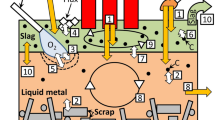Abstract
Results of work on the development of a phenomenological model for the continuous flotation process using short-lived radioactive tracer techniques for determining model parameters is reported. A model that incorporates a flotation first-order rate constant and a residence time distribution based on the cross -flow finite-stage (CFFS) model has been derived and investigated. The short-lived radioactive tracer techniques and the nonlinear search methods necessary to extract the model parameters have been developed. The conditions under which all the model parametrs can be extracted from a single radiotracer experiment are detailed and illustrated. A micro-computer-based unique data logging system has been designed, assembled, and implemented for collecting the necessary transient radiotracer data. Results are reported for a continuous laboratory flotation process for the two systems, mica ore and coal.
Similar content being viewed by others
References
Agyemang-Boateng, K., 1985, “The Use of Multiple Radioisotopes Produced from Intrinsic Elements to Trace Float-Sink Components of Coal in Coal Cleaning Processes,” Ph.D. Thesis, Department of Nuclear Engineering, North Carolina State University, Raleigh, NC.
Aissa, M., Gardner, R.P., and Verghese, K., 1984, “The On-stream Simultaneous Determination of Breakage Rate and Residence Time Distribution Parameter in Closed-Circuit Comminution Processes with Radiotracers,” Control ’84, Chap. 8, J.A. Herbst, ed., SME-AIME, New York, NY.
Arbiter, N., Harris, C.C., and Yap, R., 1969, “Flotation Cell Hydrodynamics,” Trans. SME-AIME, Vol. 244, pp. 134–148.
Bevington, P.R., 1969, Data Reduction and Error Analysis for the Physical Sciences, McGraw-Hill Book Co., New York.
Dowling, E.C., Klimpel, R.R., and Aplan, F.F., 1985, “Model Discrimination in the Flotation of a Porphyry Copper Ore,” Minerals & Metallurgical Processing, Vol. 2m No. 2, May, pp. 87–101.
Gardner, R.P., and Ely, R.L., Jr., 1967, Radioisotope Measurement Applications in Engineering, Reinhold Publishing Corp., New York.
Gardner, R.P., Lee, H.M., and Yu, B., 1980, “Development of Radioactive Tracer Methods for Applying the Mechanistic Approach to Continuous Multi-Phase Particle Flotation Processes,” Fine Particles Processing, Vol. 1, Chap. 47, P. Somasundaran, ed., AIME, New York.
Gardner, R.P., Verghese, K., and Rogers, R.S.C., 1980, “The On-Stream Determination of Large-Scale Ball Mill Residence Time Distributions with Short-Lived Radioactive Tracers,” Mining Engineering, April, pp. 422–431.
Gardner, R.P., and Verghese, K., 1985, Analysis and Design of Radioisotope Gauges and Analyzers, to be published by Plenum Publishing Corp., New York.
Himmelblau, D.M., and Bischoff, K.B., 1968, Process Analysis and Simulation: Deterministic Systems, John Wiley Sons, Inc., New York.
Imaizumi, T., and Inoue, T., 1963, “Kinetic Considerations of Froth Flotation. Proceedings, 6th International Mineral Processing Congress, Cannes, Pergamon Press.
King, R.P., Woodburn, E.T., Colburn, R.P., Edwards, R., and Smith, W.E., 1969, “Dynamic Testing of Mineral Processing Equipment Using Radioisotopes,” Nuclear Techniques and Mineral Resources, STI/PUB/198, SM-112, International Atomic Agency, Vienna.
Lee, H.M., 1983, “Development of a Suitable Mechanistic Model and Radiotracer Methods for Determining Model Parameters for the Flotation Process,” Ph.D. Thesis, Department of Nuclear Engineering, North Carolina State University, Raleigh, NC.
Marquardt, D.W., 1963, Journal, Soc. Ind. Appl. Math., Vol. 11, No. 2, p. 431.
Niemi, A., 1966, “On the Dynamics of a Pneumatic Flotation Cell,” Acta. Polytech. Scand. Chem. Incl. Metall. Ser., No. 49.
Rogers, R.S.C., and Gardner, R.P., 1979, “Use of a Finite-Stage Transport Concept for Analyzing Residence Time Distributions of Continuous Processes,” AlChE Journal, Vol. 25, No. 2, pp. 229–239.
Salmon, L., 1961, “Analysis of Gamma-Ray Scintillation Spectra by the Method of Least-Squares,” Nuclear Instruments and Methods, Vol. 14, p. 193.
Author information
Authors and Affiliations
Additional information
SME preprint 85–148, SME-AIME Annual Meeting, New York, NY, February 1985. MMP paper 85–623. Discussion of this paper must be submitted, in duplicate, prior to Jan. 31, 1987.
Rights and permissions
About this article
Cite this article
Gardner, R.P., Verghese, K., Boateng, K. et al. Radiotracer techniques in modeling continuous flotation processes. Mining, Metallurgy & Exploration 3, 225–230 (1986). https://doi.org/10.1007/BF03402485
Received:
Published:
Issue Date:
DOI: https://doi.org/10.1007/BF03402485




